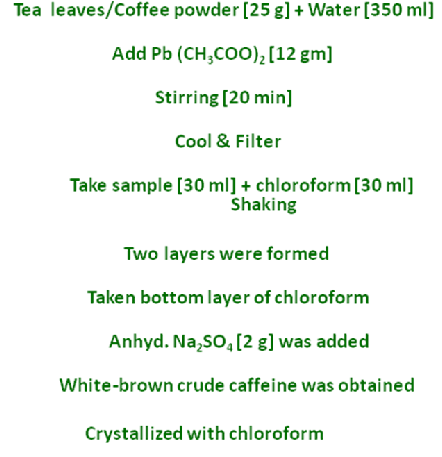Procedure
(a) Extraction of caffeine from Tea leaves/coffee powder
 |
   |
(b) Qualitative and quantitative analysis of caffeine
- A stock solution of caffeine was prepared by dissolving caffeine (1 mg) in methanol (100 ml) in a volumetric flask. The solution was sonicated for 10 minutes over an ultrasonic bath, to obtain a homogenous solution.Similarly, the crystalline caffeine samples (extracted from tea/coffee) were dissolved in methanol and then sonicated for 10 min.
- The solution was filtered through Whatman No. 41 filter paper and filtrate was used as sample solution.
- A 20cm × 10cm aluminium backed HPTLC plate coated with silica gel
60 F 254 (E. Merck, Darmstadt, Germany) was used for analysis. They were pre-washed with methanol and dried in an oven at 65oC for 10 minutes. - The samples were applied at 10 mm from the base of HPTLC plate by means of a Camag (Switzerland) Linomat V sample applicator using a syringe (100µL, Hamilton, Bonaduz, Switzerland).
- A linear calibration curve was obtained on applying the increasing concentration of standard caffeine in the range (20-140 ng). Extracted samples (4.8 and 200 µg) from tea and coffee respectively were also loaded on the same plate.
- HPTLC analysis was performed on a computerized densitometer scanner 3, controlled by winCATS planar chromatography manager version 1.4.4. (CAMAG, Switzerland).
- Plate was developed to a distance of 80 mm, in a Camag twin-trough chamber with mobile phase toluene: acetone, 4:1 (v/v).
- Plates were evaluated by densitometry at 275 nm with a Camag Scanner 3 for quantification.








